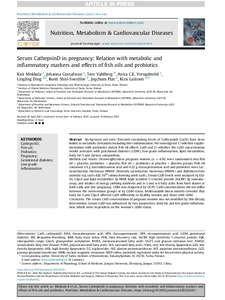Serum CathepsinD in pregnancy: Relation with metabolic and inflammatory markers and effects of fish oils and probiotics
Mokkala Kati; Gustafsson Johanna; Vahlberg Tero; Vreugdenhil Anita CE; Ding Lingling; Shiri-Sverdlov Ronit; Plat Jogchum; Laitinen Kirsi
https://urn.fi/URN:NBN:fi-fe2022081154677
Tiivistelmä
Background and aims: Elevated circulating levels of CathepsinD (CatD) have been linked to metabolic deviations including liver inflammation. We investigated 1) whether supplementation with probiotics and/or fish oil affects CatD and 2) whether the CatD concentration would associate with gestational diabetes (GDM), low-grade inflammation, lipid metabolism, body fat % and dietary composition.
Methods and results: Overweight/obese pregnant women (n = 438) were randomized into fish oil + placebo, probiotics + placebo, fish oil + probiotics or placebo + placebo groups. Fish oil contained 1.9 g docosahexaenoic acid and 0.22 g eicosapentaenoic acid and probiotics were Lacticaseibacillusrhamnosus HN001 (formerly Lactobacillusrhamnosus HN001) and Bifidobacteriumanimalis ssp. lactis 420, 1010 colony-forming units each). Serum CatD levels were analysed by ELISA, GlycA and lipid metabolites by NMR, high sensitive C-reactive protein (hsCRP) by immunoassay, and intakes of energy yielding nutrients and n-3 and n-6 fatty acids from food diaries at both early and late pregnancy. GDM was diagnosed by OGTT. CatD concentrations did not differ between the intervention groups or by GDM status. Multivariable linear models revealed that body fat % and GlycA affected CatD differently in healthy women and those with GDM.
Conclusion: The serum CatD concentration of pregnant women was not modified by this dietary intervention. Serum CatD was influenced by two parameters, body fat and low grade inflammation, which were dependent on the woman's GDM status. CLINICAL TRIAL REG. NO: NCT01922791, clinicaltrials.gov (secondary analysis).
Kokoelmat
- Rinnakkaistallenteet [27094]
